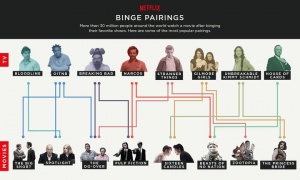Difference between revisions of "Binge Watching"
| Line 1: | Line 1: | ||
| − | Binge Watching is watching multiple episodes of a television show in a row, typically through digital streaming or DVDs <ref>Oxford Dictionary https://en.oxforddictionaries.com/definition/us/binge-watch</ref>. | + | Binge Watching is watching multiple episodes of a television show in a row, typically through digital streaming or DVDs <ref>Oxford Dictionary https://en.oxforddictionaries.com/definition/us/binge-watch</ref>. The practice of binge watching has become incredibly popular in today's society, with 61% of people saying that they regularly binge watch in a study done by Netflix in 2014 <ref>Netflix Binge Watching Study http://www.cinemablend.com/television/Unsurprising-Netflix-Survey-Indicates-People-Like-Binge-Watch-TV-61045.html</ref>. While the term binge watching has been used since the late 1990s by the circles of television fandom, it was not widely used until the term exploded in usage in 2013, even working its way onto the short list for the Oxford Dictionaries' Word of the Year that year <ref> The Oxford Dictionaries Word of the Year 2013 http://blog.oxforddictionaries.com/press-releases/oxford-dictionaries-word-of-the-year-2013/</ref>. |
==History== | ==History== | ||
| − | Binge watching began with box set DVD releases of television shows | + | Binge watching began with box set DVD releases of television shows in the late 1990s; however, it was not fully popularized until the creation of on demand viewing services and online streaming sites, gaining wide popularity in 2013, when Netflix released their own original programming <ref>The Oxford Dictionaries Word of the Year 2013 http://blog.oxforddictionaries.com/press-releases/oxford-dictionaries-word-of-the-year-2013/</ref>. These streaming sites, such as [[Netflix|Netflix]], Hulu, Amazon Prime, etc. publish full seasons of television shows, both from television networks and sometimes original content, and allow users to watch as many episodes of the show at a time as they want. This allows for people to watch as much of these shows as they want to, leading to binge watching. |
| + | |||
| + | ==Watching TV vs Binge Watching== | ||
| + | In the Netflix study done in 2014, 73% of people defining binge watching as watching 2-6 episodes of the same television show in one sitting <ref>Netflix Binge Watching Study http://www.cinemablend.com/television/Unsurprising-Netflix-Survey-Indicates-People-Like-Binge-Watch-TV-61045.html</ref>. The Atlantic, however, crowd sourced to define binge watching as watching 4 or more episodes in one sitting, claiming that 2 episodes were too few to describe as a "binge" <ref>When, Exactly, Does Watching a Lot of Netflix Become a 'Binge'? https://www.theatlantic.com/entertainment/archive/2014/02/when-exactly-does-watching-a-lot-of-netflix-become-a-binge/283844/</ref>. | ||
| + | |||
| + | ==Culture== | ||
| + | [[File:Binge Pairings.jpeg|thumbnail|Netflix Binge Pairings]] While most people see binge watching as something done by millennials, it is consistent across generations, although more prevalent in ages 18-34 <ref>Netflix Binge Watching Study http://www.cinemablend.com/television/Unsurprising-Netflix-Survey-Indicates-People-Like-Binge-Watch-TV-61045.html</ref>. While watching a few episodes might constitute binge watching, many people will watch an entire series in one or a few sittings. It is then common practice to take a "breather," or a break of at least a day, between shows. The average break size is 3 days. In this break, many people will turn to movies to continue watching something without starting a new show, with these movies often staying within the genre of the show they just finished <ref>Netflix Knows About Your Binging Breathers http://www.huffingtonpost.com/entry/netflix-binging-tv-movie-pairings-report_us_5846d233e4b02f60b024d2ca</ref>. | ||
| + | |||
| + | ==References== | ||
Revision as of 16:57, 20 February 2017
Binge Watching is watching multiple episodes of a television show in a row, typically through digital streaming or DVDs [1]. The practice of binge watching has become incredibly popular in today's society, with 61% of people saying that they regularly binge watch in a study done by Netflix in 2014 [2]. While the term binge watching has been used since the late 1990s by the circles of television fandom, it was not widely used until the term exploded in usage in 2013, even working its way onto the short list for the Oxford Dictionaries' Word of the Year that year [3].
History
Binge watching began with box set DVD releases of television shows in the late 1990s; however, it was not fully popularized until the creation of on demand viewing services and online streaming sites, gaining wide popularity in 2013, when Netflix released their own original programming [4]. These streaming sites, such as Netflix, Hulu, Amazon Prime, etc. publish full seasons of television shows, both from television networks and sometimes original content, and allow users to watch as many episodes of the show at a time as they want. This allows for people to watch as much of these shows as they want to, leading to binge watching.
Watching TV vs Binge Watching
In the Netflix study done in 2014, 73% of people defining binge watching as watching 2-6 episodes of the same television show in one sitting [5]. The Atlantic, however, crowd sourced to define binge watching as watching 4 or more episodes in one sitting, claiming that 2 episodes were too few to describe as a "binge" [6].
Culture
While most people see binge watching as something done by millennials, it is consistent across generations, although more prevalent in ages 18-34 [7]. While watching a few episodes might constitute binge watching, many people will watch an entire series in one or a few sittings. It is then common practice to take a "breather," or a break of at least a day, between shows. The average break size is 3 days. In this break, many people will turn to movies to continue watching something without starting a new show, with these movies often staying within the genre of the show they just finished [8].References
- ↑ Oxford Dictionary https://en.oxforddictionaries.com/definition/us/binge-watch
- ↑ Netflix Binge Watching Study http://www.cinemablend.com/television/Unsurprising-Netflix-Survey-Indicates-People-Like-Binge-Watch-TV-61045.html
- ↑ The Oxford Dictionaries Word of the Year 2013 http://blog.oxforddictionaries.com/press-releases/oxford-dictionaries-word-of-the-year-2013/
- ↑ The Oxford Dictionaries Word of the Year 2013 http://blog.oxforddictionaries.com/press-releases/oxford-dictionaries-word-of-the-year-2013/
- ↑ Netflix Binge Watching Study http://www.cinemablend.com/television/Unsurprising-Netflix-Survey-Indicates-People-Like-Binge-Watch-TV-61045.html
- ↑ When, Exactly, Does Watching a Lot of Netflix Become a 'Binge'? https://www.theatlantic.com/entertainment/archive/2014/02/when-exactly-does-watching-a-lot-of-netflix-become-a-binge/283844/
- ↑ Netflix Binge Watching Study http://www.cinemablend.com/television/Unsurprising-Netflix-Survey-Indicates-People-Like-Binge-Watch-TV-61045.html
- ↑ Netflix Knows About Your Binging Breathers http://www.huffingtonpost.com/entry/netflix-binging-tv-movie-pairings-report_us_5846d233e4b02f60b024d2ca
